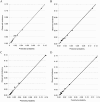Predicting peripartum blood transfusion in women undergoing cesarean delivery: A risk prediction model
- PMID: 30551126
- PMCID: PMC6294610
- DOI: 10.1371/journal.pone.0208417
Predicting peripartum blood transfusion in women undergoing cesarean delivery: A risk prediction model
Erratum in
-
Correction: Predicting peripartum blood transfusion in women undergoing cesarean delivery: A risk prediction model.PLoS One. 2019 Jan 23;14(1):e0211360. doi: 10.1371/journal.pone.0211360. eCollection 2019. PLoS One. 2019. PMID: 30673777 Free PMC article.
Abstract
Objective: There has been an appreciable rise in postpartum hemorrhage requiring blood transfusions in the United States. Our objective is to better define patients at greatest risk for peripartum transfusion at the time of cesarean in order to identify cases for early intervention and monitoring.
Methods: Our study is a secondary analysis of a retrospective cohort study. Cases of intraoperative and immediate postpartum blood transfusion among women undergoing cesarean delivery were identified. Multivariable logistic regression models were used to identify antepartum and intrapartum risk factors that were independently associated with blood transfusion. A risk calculator was then developed to predict the need for transfusion.
Results: Of 56,967 women, 1488 (2.6%) required any blood transfusion. The strongest risk factors for peripartum blood transfusion included anemia (odds ratio [OR] 3.7, 95% CI 3.3-4.3), abruption on presentation (OR 3.3, CI 2.6-4.1), general anesthesia (OR 5.2, CI 4.4-6.1) and abnormal placentation (OR 92.0, CI 57.4-147.6). An antepartum (model 1) and combined antepartum plus intrapartum risk model (model 2) were developed (model 1 AUC = 0.77, model 2 AUC = 0.83) and internally validated.
Conclusions: Among women who required cesarean delivery, we were able to identify risk factors which predispose women to peripartum blood transfusion and developed a prediction model with good discrimination.
Conflict of interest statement
The authors have declared that no competing interests exist.
Figures


Similar articles
-
Antepartum risk factors and outcomes of massive transfusion for elective cesarean section: a nationwide retrospective cohort study.BMC Pregnancy Childbirth. 2024 Oct 24;24(1):699. doi: 10.1186/s12884-024-06875-4. BMC Pregnancy Childbirth. 2024. PMID: 39448931 Free PMC article.
-
Risk factors for postpartum hemorrhage requiring transfusion in cesarean deliveries for Japanese twins: comparison with those for singletons.Arch Gynecol Obstet. 2012 Dec;286(6):1363-7. doi: 10.1007/s00404-012-2461-9. Epub 2012 Jul 19. Arch Gynecol Obstet. 2012. PMID: 22810621
-
Peripartum hysterectomy due to severe postpartum hemorrhage: A hospital-based study.Acta Obstet Gynecol Scand. 2022 Jul;101(7):819-826. doi: 10.1111/aogs.14358. Epub 2022 Apr 7. Acta Obstet Gynecol Scand. 2022. PMID: 35388907 Free PMC article.
-
Placenta previa, placenta accreta, and vasa previa.Obstet Gynecol. 2006 Apr;107(4):927-41. doi: 10.1097/01.AOG.0000207559.15715.98. Obstet Gynecol. 2006. PMID: 16582134 Review.
-
Placenta accreta spectrum: accreta, increta, and percreta.Obstet Gynecol Clin North Am. 2015 Jun;42(2):381-402. doi: 10.1016/j.ogc.2015.01.014. Obstet Gynecol Clin North Am. 2015. PMID: 26002174 Review.
Cited by
-
Factors associated with severe maternal outcome in patients admitted to an intensive care unit in northeastern Brazil with postpartum hemorrhage: a retrospective cohort study.BMC Pregnancy Childbirth. 2023 Aug 10;23(1):573. doi: 10.1186/s12884-023-05874-1. BMC Pregnancy Childbirth. 2023. PMID: 37563728 Free PMC article.
-
Perinatal outcome in pregnant women: the impact of blood transfusion.Blood Transfus. 2025 May-Jun;23(3):216-222. doi: 10.2450/BloodTransfus.864. Epub 2025 Jan 21. Blood Transfus. 2025. PMID: 39949026 Free PMC article.
-
Antepartum risk factors and outcomes of massive transfusion for elective cesarean section: a nationwide retrospective cohort study.BMC Pregnancy Childbirth. 2024 Oct 24;24(1):699. doi: 10.1186/s12884-024-06875-4. BMC Pregnancy Childbirth. 2024. PMID: 39448931 Free PMC article.
-
Validation of Three Models for Prediction of Blood Transfusion during Cesarean Delivery Admission.Am J Perinatol. 2024 May;41(S 01):e3391-e3400. doi: 10.1055/a-2234-8171. Epub 2023 Dec 22. Am J Perinatol. 2024. PMID: 38134939 Free PMC article. Clinical Trial.
-
Prevalence and Associated Factors for Post-Caesarean Delivery Blood Transfusion in Eastern Sudan: A Cross-Sectional Study.J Blood Med. 2022 May 9;13:219-227. doi: 10.2147/JBM.S355846. eCollection 2022. J Blood Med. 2022. PMID: 35585876 Free PMC article.
References
-
- Callaghan WM, Grobman WA, Kilpatrick SJ, Main EK, DʼAlton M. Facility-based identification of women with severe maternal morbidity: it is time to start. Obstet Gynecol. 2014;123: 978–81. 10.1097/AOG.0000000000000218 - DOI - PMC - PubMed
-
- Grobman WA, Bailit JL, Rice MM, Wapner RJ, Reddy UM, Varner MW, et al. Frequency of and factors associated with severe maternal morbidity. Obstet Gynecol. 2014;123: 804–810. 10.1097/AOG.0000000000000173 - DOI - PMC - PubMed
-
- Knight M, Callaghan WM, Berg C, Alexander S, Bouvier-Colle MH, Ford JB, et al. Trends in postpartum hemorrhage in high resource countries: A review and recommendations from the international postpartum hemorrhage collaborative group. Obstet Gynecol Surv. 2010;65: 211–212. 10.1097/01.ogx.0000371705.17102.c4 - DOI - PMC - PubMed
-
- McLintock C, James AH. Obstetric hemorrhage. J Thromb Haemost. 2011;9: 1441–1451. 10.1111/j.1538-7836.2011.04398.x - DOI - PubMed
-
- World Health Organization. WHO recommendations for the prevention and treatment of postpartum haemorrhage [Internet]. 2012. Available: http://www.who.int/reproductivehealth/publications/maternal_perinatal_he... - PubMed
Publication types
MeSH terms
Grants and funding
LinkOut - more resources
Full Text Sources
Medical

